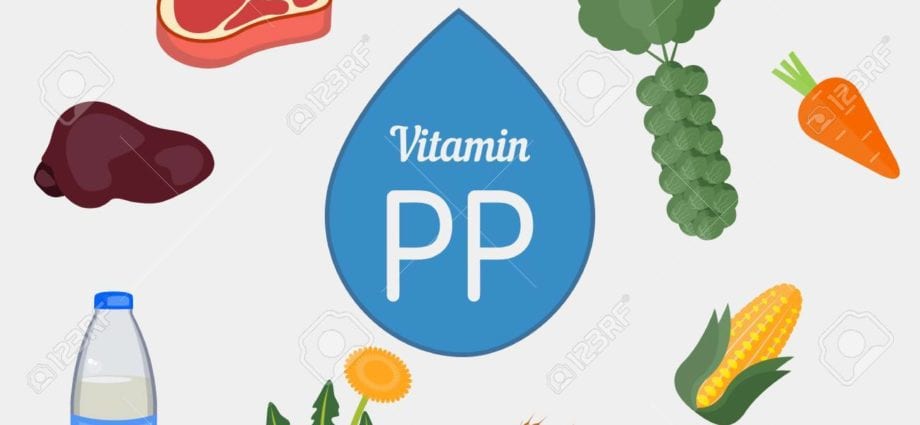Contents
Other names for vitamin PP are niacin, niacinamide, nicotinamide, nicotinic acid. Be careful! In foreign literature, the designation B3 is sometimes used. In the Russian Federation, this symbol is used for designation.
The main representatives of vitamin PP are nicotinic acid and nicotinamide. In animal products, niacin is found in the form of nicotinamide, and in plant products, it is in the form of nicotinic acid.
Nicotinic acid and nicotinamide are very similar in their effect on the body. For nicotinic acid, a more pronounced vasodilator effect is characteristic.
Niacin can be formed in the body from the essential amino acid tryptophan. It is believed that 60 mg of niacin is synthesized from 1 mg of tryptophan. In this regard, a person’s daily need is expressed in niacin equivalents (NE). Thus, 1 niacin equivalent corresponds to 1 mg of niacin or 60 mg of tryptophan.
Vitamin PP Rich Foods
Indicated approximate availability in 100 g of product
Daily requirement of vitamin PP
The daily requirement for vitamin PP is: for men – 16-28 mg, for women – 14-20 mg.
The need for vitamin PP increases with:
- heavy physical exertion;
- intense neuropsychic activity (pilots, dispatchers, telephone operators);
- in the Far North;
- work in hot climates or in hot workshops;
- pregnancy and lactation;
- low-protein diet and the predominance of plant proteins over animals (vegetarianism, fasting).
Useful properties and its effect on the body
Vitamin PP is necessary for the release of energy from carbohydrates and fats, for protein metabolism. It is part of the enzymes that provide cellular respiration. Niacin normalizes the stomach and pancreas.
Nicotinic acid has a beneficial effect on the nervous and cardiovascular systems; maintains healthy skin, intestinal mucosa and oral cavity; participates in the maintenance of normal vision, improves blood supply and reduces high blood pressure.
Scientists believe that niacin prevents normal cells from becoming cancerous.
Lack and excess of vitamin
Signs of vitamin PP deficiency
- lethargy, apathy, fatigue;
- dizziness, headache;
- irritability;
- insomnia;
- decreased appetite, weight loss;
- pallor and dryness of the skin;
- palpitation;
- constipation;
- decrease in the body’s resistance to infections.
With prolonged vitamin PP deficiency, pellagra disease can develop. Early symptoms of pellagra are:
- diarrhea (stool 3-5 times or more a day, watery without blood and mucus);
- loss of appetite, heaviness in the stomach;
- heartburn, belching;
- burning mouth, drooling;
- redness of the mucous membrane;
- swelling of the lips and the appearance of cracks on them;
- the papillae of the tongue protrude as red dots, and then smooth out;
- deep cracks are possible in the tongue;
- red spots appear on the hands, face, neck, elbows;
- swollen skin (it hurts, itches and blisters appear on it);
- severe weakness, tinnitus, headaches;
- sensations of numbness and creeping;
- shaky gait;
- arterial pressure.
Signs of excess vitamin PP
- skin rash;
- itching;
- fainting.
Factors affecting the content of Vitamin PP in products
Niacin is quite stable in the external environment – it can withstand long-term storage, freezing, drying, exposure to sunlight, alkaline and acidic solutions. But with conventional heat treatment (cooking, frying), the niacin content in products is reduced by 5-40%.
Why Vitamin PP Deficiency Occurs
With a balanced diet, the need for vitamin PP is fully satisfied.
Vitamin PP can be present in foods in both readily available and tightly bound form. For example, in cereals, niacin is just in such a difficult-to-obtain form, which is why vitamin PP is poorly absorbed from cereals. An important case is corn, in which this vitamin is in a particularly unfortunate combination.
Elderly people may not have enough vitamin PP even with sufficient dietary intake. their assimilation is disturbed.










